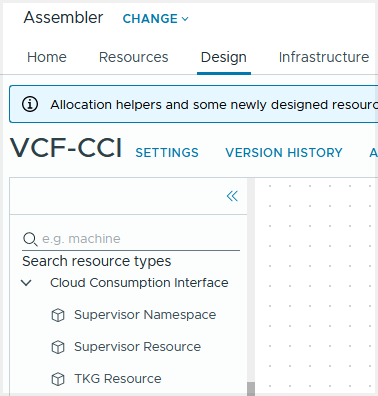You can add Cloud Consumption Interface (CCI) elements to use the CCI service within a VMware Aria Automation template so that your users can request Kubernetes-based workloads using the Virtual Machine service and Tanzu Kubernetes Grid service within a supervisor namespace.
To see the CCI elements, expand the Cloud Consumption Interface section within the resource library in your cloud template or type cci in the Search resource types field.

| Supervisor Namespace resource
|
Create a new Supervisor Namespace, that provides a Kubernetes-based workspace with resource limits, user access, and available Supervisor services, so that users can provision VM and TKG resources based on application needs. |
| Supervisor resource
|
Create any supported Supervisor Kubernetes resource within a Supervisor Namespace, such as virtualmachines, virtualmachineservices, tanzukubernetesclusters, persistentvolumeclaims, secrets, and so on, depending on the Kubernetes manifest passed to the Supervisor resource that is being configured. |
| TKG resource
|
Create any supported Kubernetes resource within a TKG cluster. |
Supervisor Namespace Resource example
CCI.Supervisor.Namespace represents the Supervisor Kubernetes-based workspace where the user-managed vSphere Supervisor IaaS resources for the application are created.
This example defines a CCI supervisor namespace resource named cciNamespace to provision a Supervisor Namespace called demo.
formatVersion: 1
inputs: {}
resources:
cciNamespace:
type: CCI.Supervisor.Namespace
properties:
name: demo
className: default
regionName: dev-us-west
Supervisor Resource example
You use CCI.Supervisor.Resource to pass the Kubernetes manifest for Kubernetes objects supported to run within a supervisor namespace context.
- To provision the supervisor resource within a particular supervisor namespace, you configure the supervisor resource context property by mapping it to the Supervisor Namespace ID using a template bind expression, for example context: ${resource.cciNamespace.id}.
- To specify the objects to provision, you configure the manifest property of the Supervisor Resource by passing the Kubernetes manifest to the Kubernetes object that you are creating.
formatVersion: 1
inputs: {}
resources:
cciTKGCluster:
type: CCI.Supervisor.Resource
properties:
context: ${resource.cciNamespace.id}
manifest:
apiVersion: cluster.x-k8s.io/v1beta1
kind: Cluster
metadata:
name: ${input.tkg_Name}
labels:
tkg-cluster-selector: ${input.tkg_Name}
spec:
clusterNetwork:
cni:
name: antrea
pods:
cidrBlocks:
- 192.168.156.0/20
services:
cidrBlocks:
- 10.96.0.0/12
serviceDomain: cluster.local
topology:
class: tanzukubernetescluster
version: v1.24.9---vmware.1-tkg.4
variables:
- name: storageClasses
value:
- tmm-kubernetes-storage-policy
- name: defaultStorageClass
value: tmm-kubernetes-storage-policy
- name: vmClass
value: ${input.controlPlaneVmClassName}
- name: storageClass
value: tmm-kubernetes-storage-policy
controlPlane:
replicas: ${input.controlPlaneCount}
metadata:
annotations:
run.tanzu.vmware.com/resolve-os-image: os-name=photon
workers:
machineDeployments:
- class: node-pool
name: ${input.tkg_Name}-nodepool
replicas: ${input.workerCount}
metadata:
annotations:
run.tanzu.vmware.com/resolve-os-image: os-name=photon
variables:
overrides:
- name: vmClass
value: ${input.workerVmClassName}
formatVersion: 1
inputs: {}
resources:
vm:
type: CCI.Supervisor.Resource
properties:
context: ${resource.cciNamespace.id}
manifest:
apiVersion: vmoperator.vmware.com/v1alpha1
kind: VirtualMachine
metadata:
finalizers:
- virtualmachine.vmoperator.vmware.com
generation: 1
labels:
vm-selector: vm-2rfx
name: vm-2rfx
spec:
className: best-effort-xsmall
imageName: vmi-c3d184be88e1af1cd
networkInterfaces:
- networkType: nsx-t
powerOffMode: hard
powerState: poweredOn
restartMode: hard
storageClass: vsan-default-storage-policy
suspendMode: hard
wait:
conditions:
- type: VirtualMachinePrereqReady
status: "False"
reason: VirtualMachineImageNotReady
indicatesFailure: true
TKG Resource example
- To bind a TKG resource to a TKG cluster, you map the ID of the supervisor TKG Cluster resource with the context property, for example context: ${resource.cciTKGCluster.id}.
- If you are creating a namespace within a TKG resource named cciTKGNamespace for example, you can bind a TKG resource to the namespace by inserting the name of the TKG resource in the context property or context: ${resource.cciTKGNamespace.id}.
- The Kubernetes manifest that is passed within the resource properties specifies the type of the Kubernetes object to provision.
...
tkgSecret:
type: CCI.TKG.Resource
properties:
context: ${resource.cciTKGCluster.id}
manifest:
apiVersion: v1
kind: Secret
metadata:
name: nvaie-apikey
type: Opaque
data:
username: KM9hdCCodG9rZW4=
password: ${base64_encode(input.password)}
...
Adding a wait property
- Field Wait: List of fields where each field can be configured with a property path and a value. The value must be matched before the resource is considered completed.
- Condition Wait: List of conditions that indicate success or failure of resource creation.
...
wait:
fields:
- path: status.loadBalancer.ingress[0].ip
value: "*"
...